(( Buckle )) Lark's Head Knot
Variation on the Bracelet Buckle - Made With Mixed Knots
Introduction
This tutorial will show you how to start your bracelet with a simple, quick buckle that can be used with any pattern.
Variation 1
I will be making pattern 58637
Step 1
First cut your strings to desired length, making the one you want to use for the buckle about 8 inches (20 cm) - 13 inches (30 cm) longer. Usually I choose the edge string for the buckle. In this case, that would be colour A.
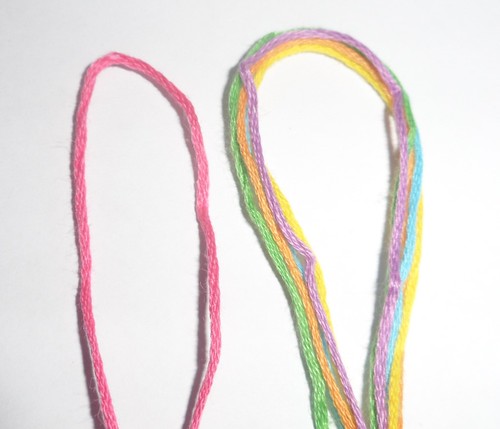
Step 2
Once your strings are cut, fold them in half and make a lark's head knot.
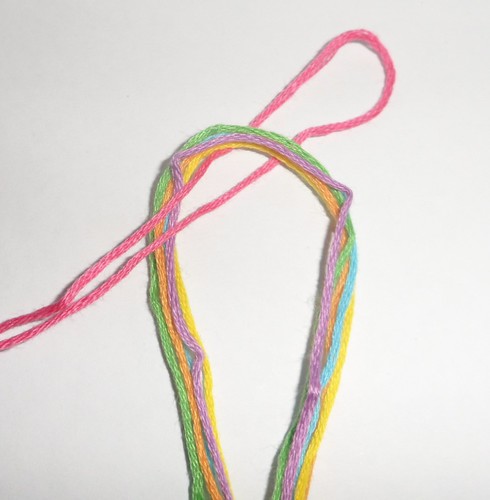
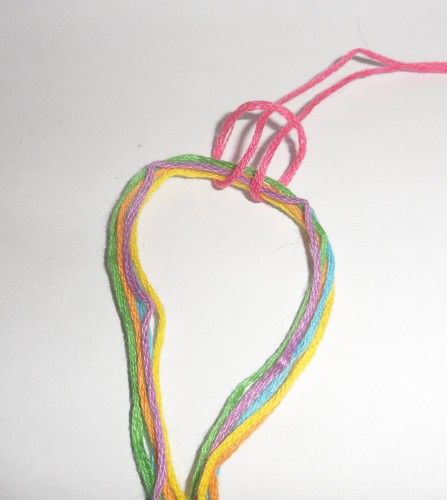
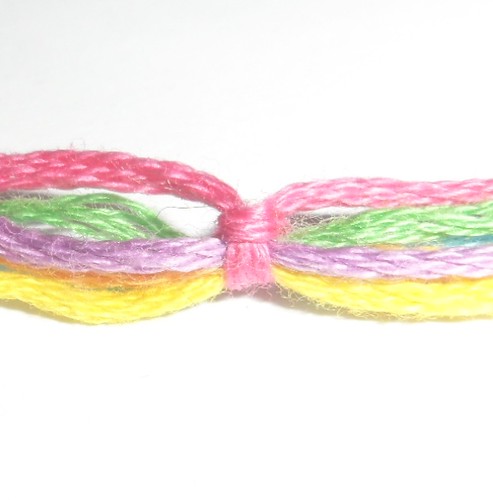
Step 3
Now you have the middle/start of the buckle done. Starting on one side, alternate doing forward half hitches and backward half hitches for about half an inch. A half hitch is half of one knot you make in normal patterns.
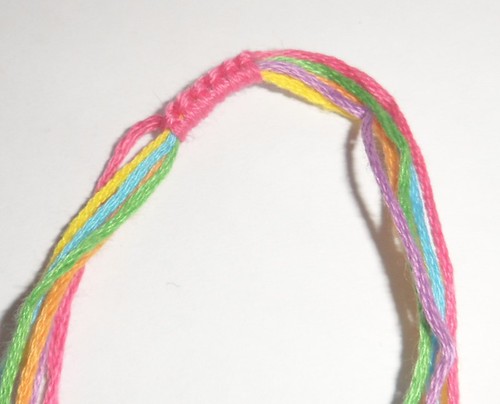
Step 4
Then, do the other half using the same technique until you get the desired length. Of course this will be larger or smaller depending on how large the pattern is.
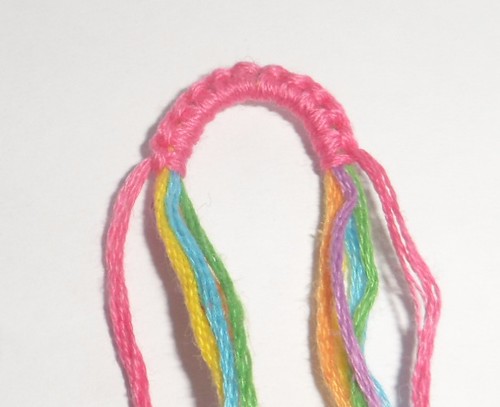
Step 5
Your buckle is complete! Fold it in half and begin your bracelet. You can use Foz's tutorial if you need help making a straight first row.

Variation 2-Loose strings
How to seamlessly add single strings to the buckle
I will be making pattern 2112
Step 1
First cut your strings to desired length, making the one you want to use for the buckle about 8 inches (20cm) longer. This pattern has an uneven amount of colors A and C, so I cut half the amount I would normally to fold it plus an inch to hide in the buckle. Usually I choose the edge string for the buckle. In this case, that would be color A.
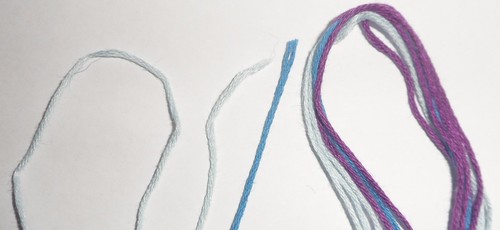
Step 2
Once your strings are cut, fold all the longer strings in half. For the loose half strings, place them about an inch past the halfway mark and make a lark's head knot including them. (If you do not know how to make a lark's head knot please look above.)
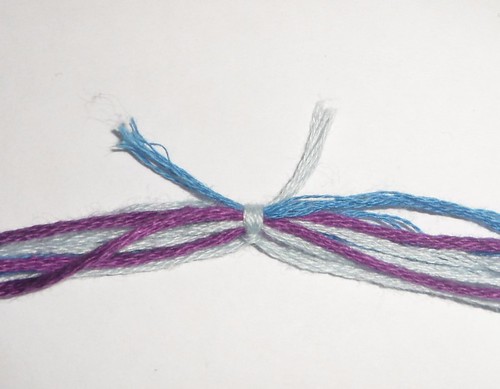
Step 3
Now you have the middle/start of the buckle done. Starting on one side, alternate doing forward half hitches and backward half hitches for about half an inch. A half hitch is half of one knot you make in normal patterns. Make sure you go around the loose strings!
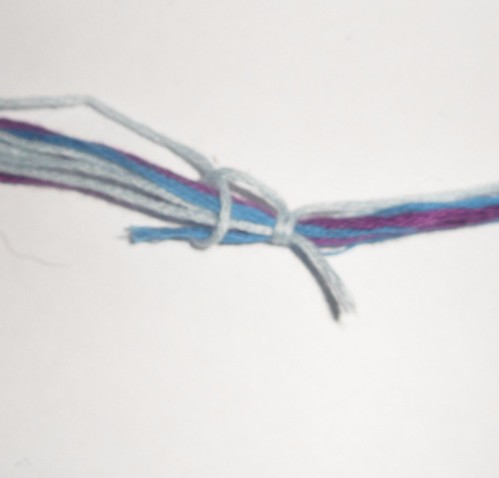
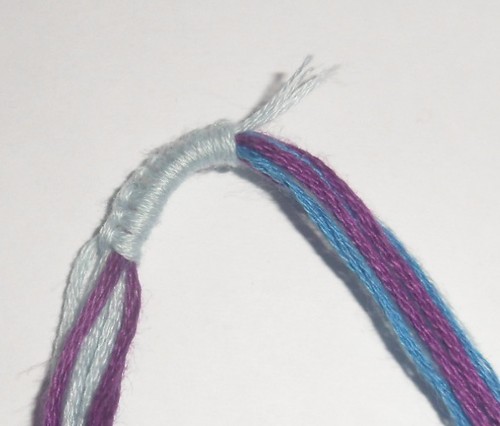
Step 4
Then, do the other half using the same technique until you get the desired length. Of course this will be larger or smaller depending on how large the pattern is.
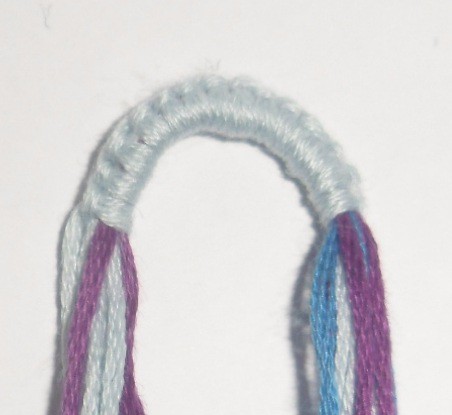
Step 5
Your buckle is complete! Fold it in half and begin your bracelet. You can use Foz's tutorial if you need help making a straight first row.
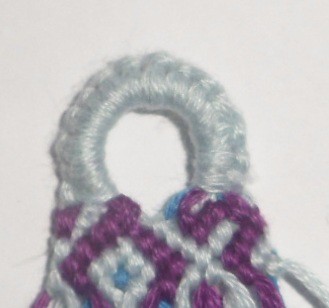
Barnacle Knot Buckle, technique with more options.
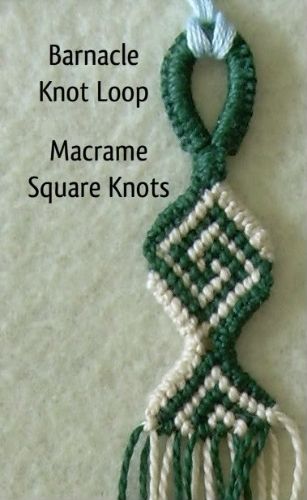
The barnacle knot is essentially alternating half hitches (Forward-Backward or Backward-Forward Knots) that are made over a core that is either already in a loop, or will be made into a loop later. This buckle forms a teardrop shaped eye that can be used for a button or with a single braid finish. Another alternative is to make the loop small enough that a double overhand knot in the cord at the end can be a ball shaped button.

To buckle with a single braid, the braid is fed up through the buckle, around the neck and back down the hole to form a secure, easily adjustable connection.
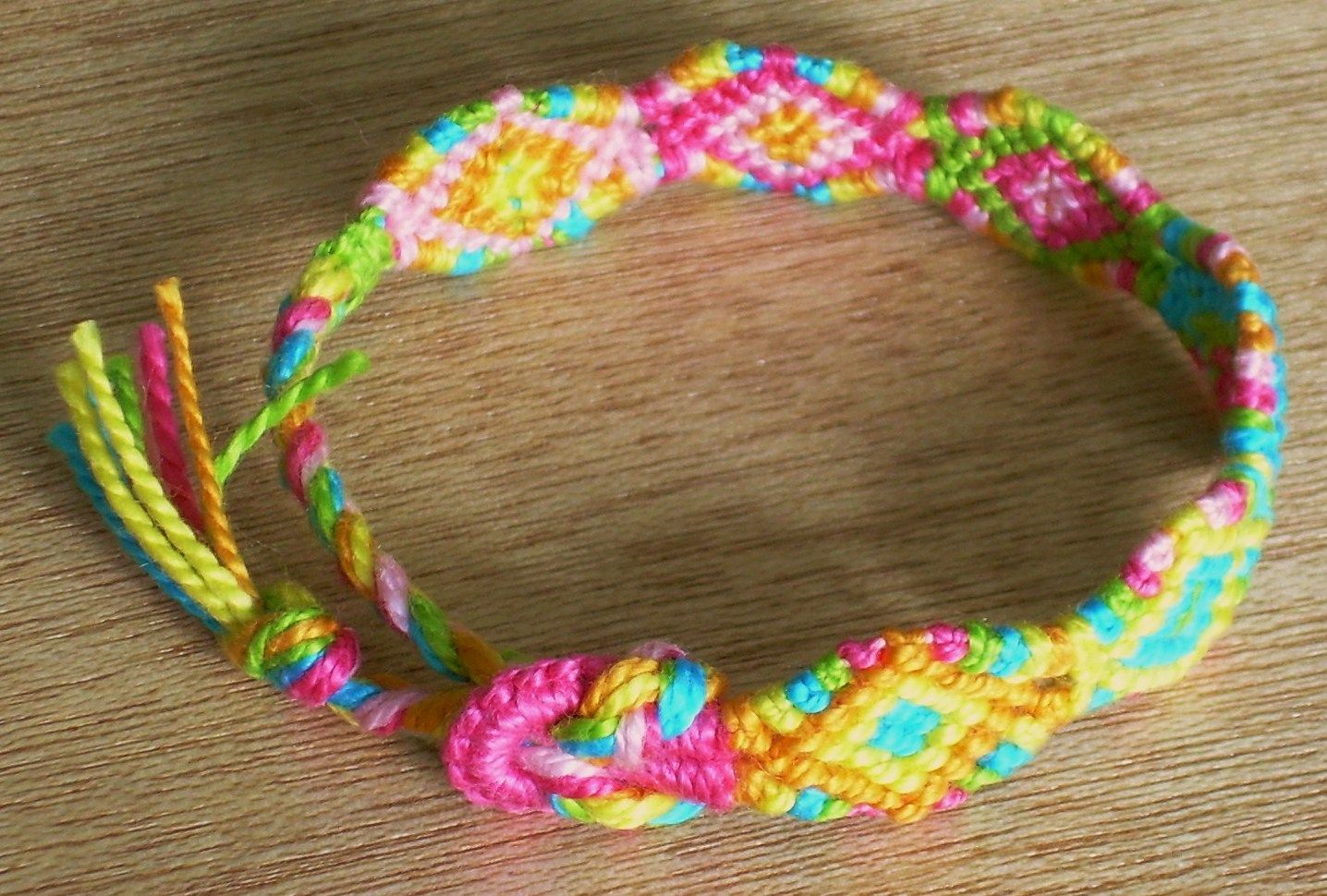
Any bracelet's pattern can be started with a bundle. Then shaped out to the pattern width using the methods shown in the Shaped Circle Bracelet Tutorial. A taper to finish can be done like the bottom half of the pattern.
To start some decisions must be made.
How many strings, think before you cut them and lay them out, options:.
a)Barnacle Knot can be made from a totally separate string.[/h2] It will be secure on its own. It does not have to be made from one of your pattern strings (though it can be). String for the buckle and a pull string loop will be needed. I tend to use a doubled strand of waste floss, looped and tied into a circle with a fat knot . . . that way I can't possibly lose the end.
How much floss do you need? 16 inches is generous for most bracelets. You can actually calculate it
Circumference of buckle desired x 6, then add 4 inches for margin. So, for a 2 inch length of barnacle knot, making a teardrop just under an inch long, 2x6+4=16 inches. If you are like me, then you have lots of lengths like this around, too long to toss and too short for a bracelet string.
If you are making the Barnacle knot with a separate string, just leave any "half" or "odd" strings for your pattern long enough so its tail goes all the way round the buckle in the core bundle. The tight buckle made from a completely separate string will hold it. You'll snip them after the buckle is finished, just before you bend it.
[h3]b)One End of Barnacle Knot String can be used in the bracelet pattern.
Cut your Barnacle knot string about longer than usual to accommodate the buckle knots (16 inches or calculate as just above). Lay it so that it crosses the center by more than the length of the buckle. The long end will be used to tie the Barnacle Knot; its short Waste Tail (other end of the string) will be hidden and secured under the buckle.
c) Both ends of the Barnacle Knot String can be used in the bracelet pattern.
For this, line one end of the string up with the others, the other will be longer (by about 16 inches . . . that will be your working tail string for making the barnacle knot. Do NOT center this string, Leave it 16 inches longer on the "Working Tail" end.d)String used for the bracelet is very slippery or of mixed types.
Accommodations should be made when using slippery string. Some situations:-- floss, such as Silk, Rayon, etc. Can be very slippery. Rayon floss, which is super shiny, wears great, and is terribly slippery. I've also soft braided fly fishing line in bracelets--mega slippery but fun.
--adding in metalic or sparkly prism threads. I've also mixed multiple strands of metalic or glow in the dark thread in with my floss.
---Several strands of machine embroidery thread makes a great "fake" floss.
--Fine rattail (satin cord) through the bracelet to pop out as part of a flower, bow, or leaf because it sort of fluffs up.
For situations like these, minimize the likelihood of the threads scooting around, by interlocking them in single pairs. If you look at the photo below. You'll see that a double length black cord and a double length white cord are actually folded through each other and doubled back. The little "bump" formed is not noticeable in the final bracelet, but wrapped under the snug Barnacle knot, they will not slip.
If you have "short" strings, don't feed them straight through the buckle. Fold them back and interlock them individually through one of the other cords that has been doubled back on itself near the center. Now one side has two ends of the same string and the other side has the single "odd" string.
Two Odd strings can be interlocked (folded back through each other); just leave enough of a tail on each so it can be clipped after the buckle is done.
When you fold interlock the strings, stagger the locations a bit, so they are not all on top of one another. Also, always do them in individual pairs. Don't fold 2 strings together on one side and loop one or two through them--you'll get a noticeable bump.
Set Up and Get Started
What you see here is everything I use to make bracelets. No glue, or other stuff. The only thing consumable is string/floss.Lay out your strings, Clamp, tie on the Barnacle Knot String
then mark the center in some way (a fine thread will do temporarily. Then line up your barnacle knot string and make an initializing overhand knot with the working end going "up" and the Waste Tail going down (this waste tail could be as long as your other strings if it's to be part of the bracelet pattern).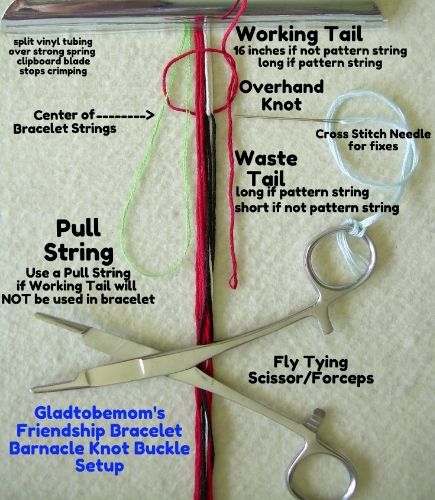
Proceed with Backwrd Forward Knots
, pulled to the right side. Keep them well aligned and make sure the wrap is abutted, smooth and not overlapped or with gaps.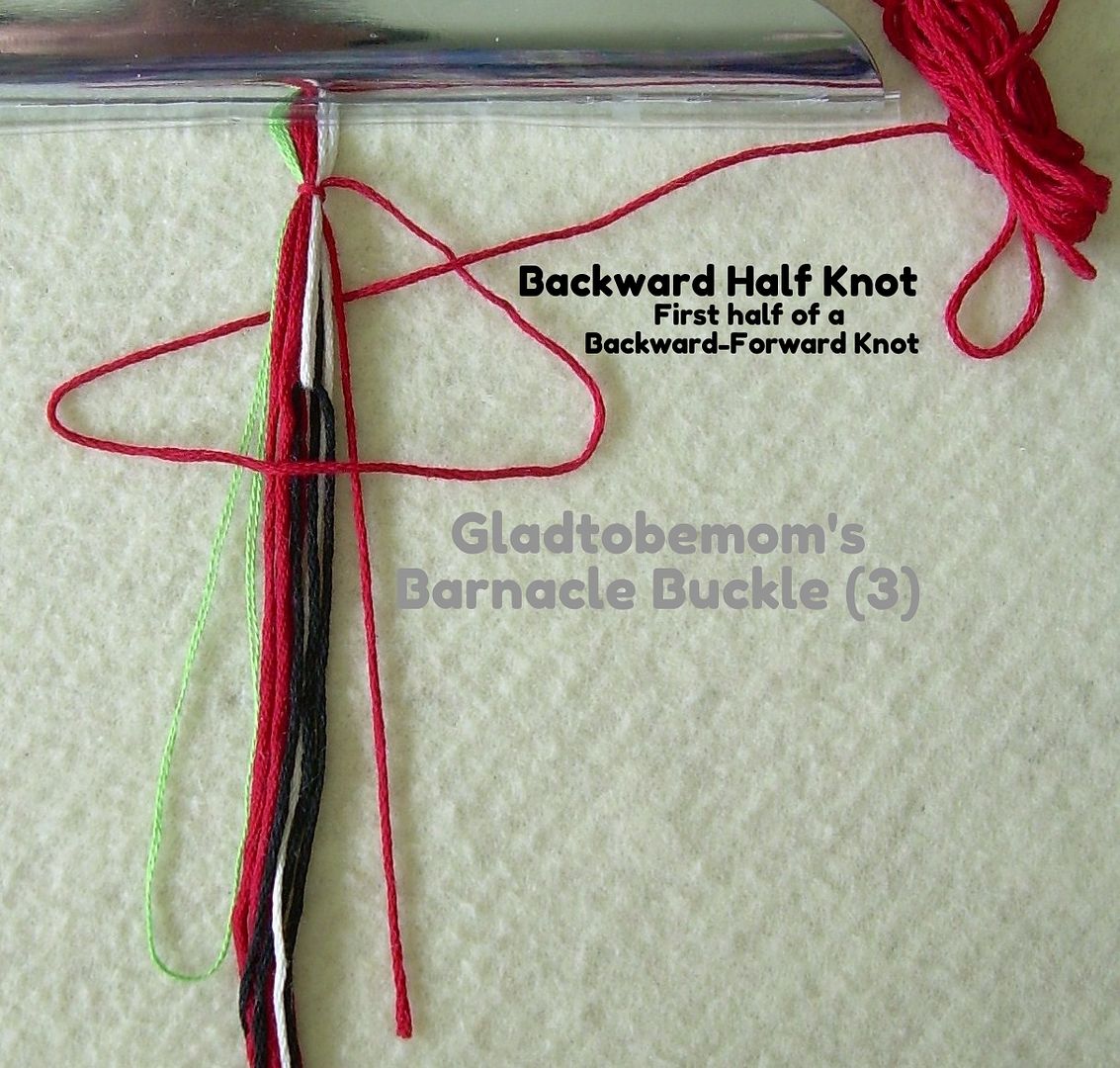
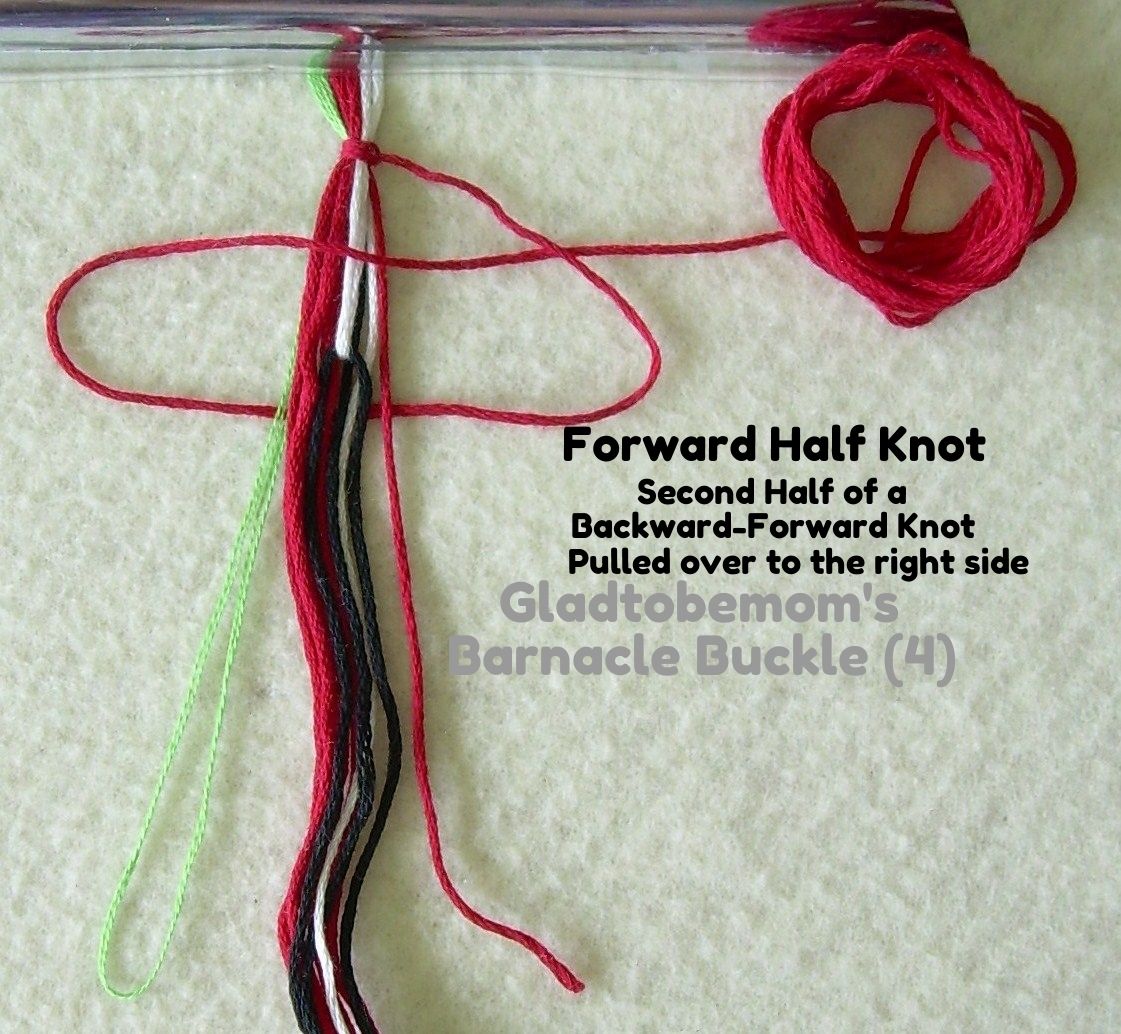
Snipping the Waste Tail if it's not to be part of the pattern.
Only if your waste tail is NOT going to be used in the pattern. When just past the center point, snip the waste tail if you are not using this string in the pattern.
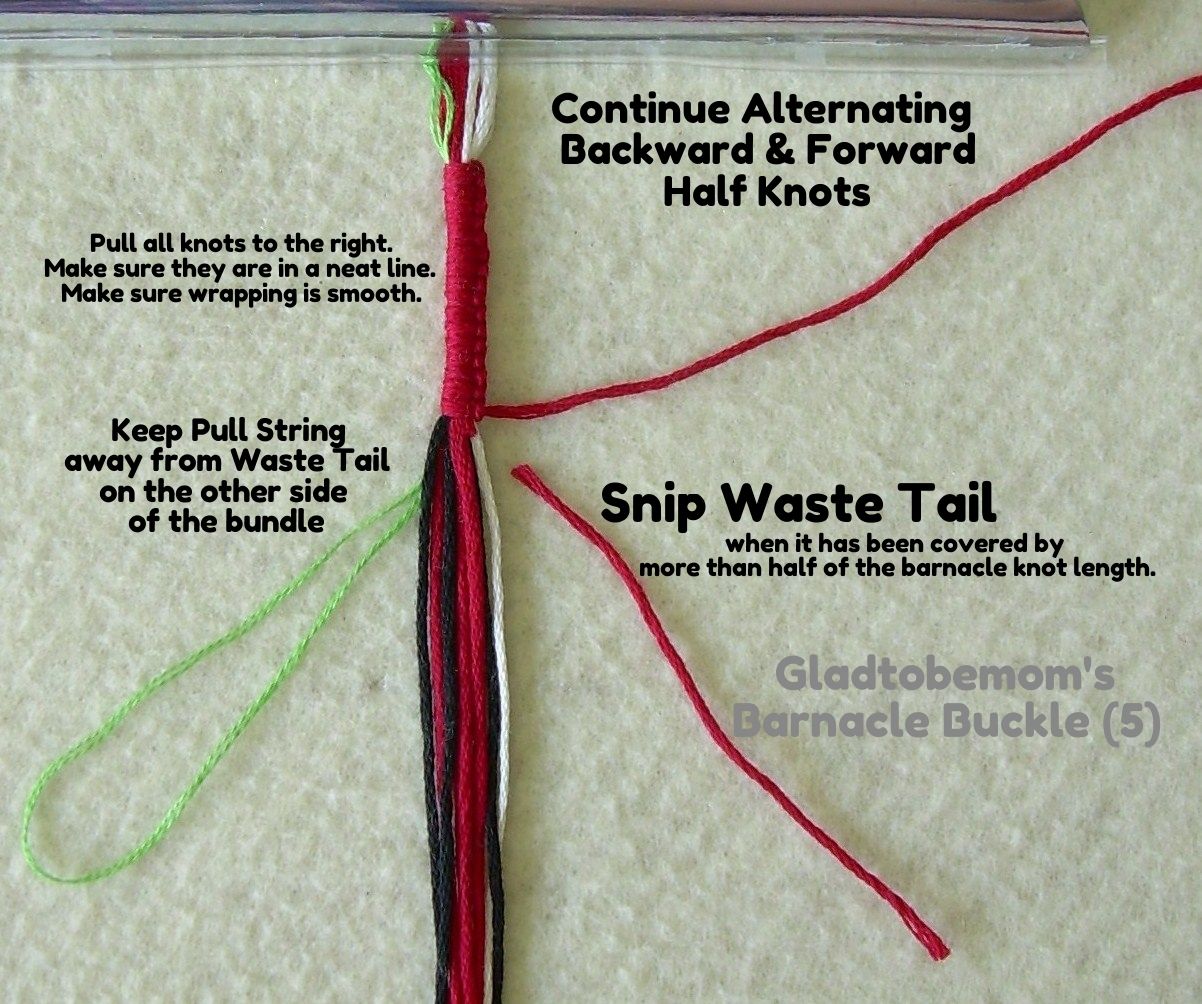
Continue with the BF knots till long enough.
Test your barnacle knot by folding it in half with the bumps outward. When it is the size you want, stop knotting.Securing the Working Tail (skip if the working tail is going to be used in the pattern of the bracelet.)
If the working string is NOT joining the bracelet pattern, then you will use the pull string to secure and hide the end.
Put the end of the Working string into the loop as shown below. Be sure to leave plenty of slack.
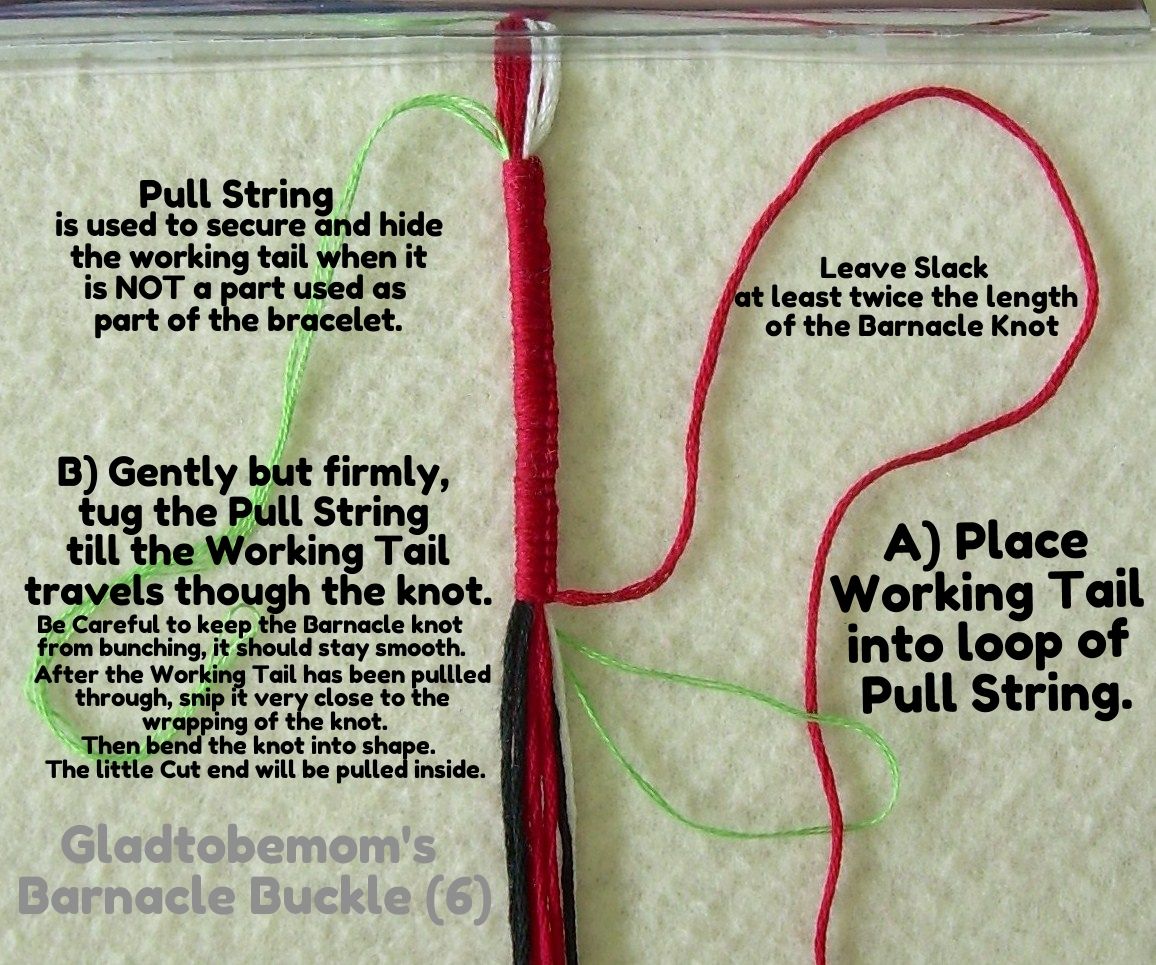
Support the barnacle knot with your fingers while you pull the working string through the barnacle knot and then snip it off. Be gentle and go slow so that the wraps won't bunch up.
Now finish off your Buckle
Bend it into shape. At this point you can choose to just start your bracelet pattern (as shown below in the open version of the buckle). Alternatively, pick up two of your pattern threads on opposite sides and do some Macrame square knots around the bundle. (as shown in the closed versions)
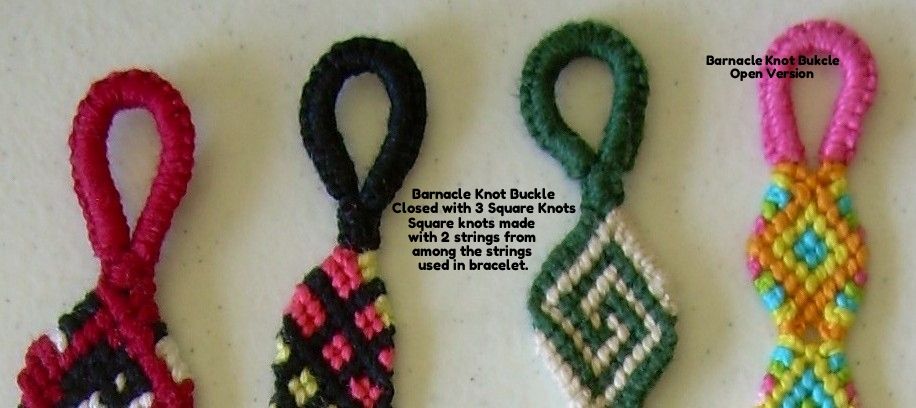
Macrame Square Knot Neck below the Buckle
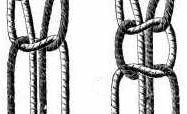
Note: this image is from a book by Theresa Dillmont, The Encyclopedia of Needlework (out of copyright, available at the Gutenberg Project site)
Some things to think about.
If you want to start with a shaped end, just take your pattern and pick a spot to start. Draw an inverted V on the pattern. This will tell you the order of your strings. Here are links to my pattern drafts for the
Shaped Yin Yang
Shaped Greek Key
Shaped Circle
The other pattern shown on this page is Pattern #48256. I did taper the start and finish of this pattern.
If you are shaping/tapering the beginning, end, or whole bracelet. It's useful to view the Shaped Circle Tutorial.
There is also a general Shaped Bracelets With Patterns Tutorial that deals with other aspects of converting a pattern.
I can't, in any way, claim to have invented this buckle. Years ago (sometime around 1972 when I was 11) I saw it in a Seaman's Skills and Hobbies (paraphrased from memory) book. This is a way that cord was turned into an "eye." In that book, there was a "recipe" for making a patterned belt using loads of half hitches (Friendship Bracelet Knots).
The "belt and buckle" was referred to as:
Barnacle Knot Buckle
Loop and Larkshead Buckle (Note that from a certain point of view, a Larkshead knot is just a FB or BF knot.)
Cat's Tail Buckle Belt (The tail going through the buckle, reaching round the neck and going back down the hole is like a cat's tail winding round.)
Cat's Paw Buckle
Sailor's Diet Buckle (Sailors often lost weight while at sea, so they had to keep adjusting their belt. They wore rope belts and saved their leather ones for when they were in port.)
Editors
The original author of this tutorial is Alicat .

Moderator comments Show comments